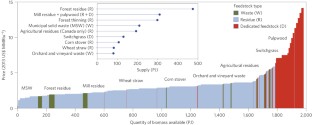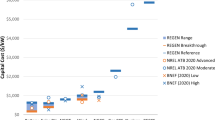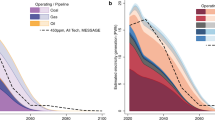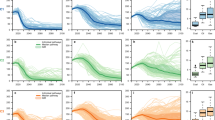Abstract
Sustainable biomass can play a transformative role in the transition to a decarbonized economy, with potential applications in electricity, heat, chemicals and transportation fuels1,2,3. Deploying bioenergy with carbon capture and sequestration (BECCS) results in a net reduction in atmospheric carbon. BECCS may be one of the few cost-effective carbon-negative opportunities available should anthropogenic climate change be worse than anticipated or emissions reductions in other sectors prove particularly difficult4,5. Previous work, primarily using integrated assessment models, has identified the critical role of BECCS in long-term (pre- or post-2100 time frames) climate change mitigation, but has not investigated the role of BECCS in power systems in detail, or in aggressive time frames6,7, even though commercial-scale facilities are starting to be deployed in the transportation sector8. Here, we explore the economic and deployment implications for BECCS in the electricity system of western North America under aggressive (pre-2050) time frames and carbon emissions limitations, with rich technology representation and physical constraints. We show that BECCS, combined with aggressive renewable deployment and fossil-fuel emission reductions, can enable a carbon-negative power system in western North America by 2050 with up to 145% emissions reduction from 1990 levels. In most scenarios, the offsets produced by BECCS are found to be more valuable to the power system than the electricity it provides. Advanced biomass power generation employs similar system design to advanced coal technology, enabling a transition strategy to low-carbon energy.
This is a preview of subscription content, access via your institution
Access options
Subscribe to this journal
Receive 12 print issues and online access
$209.00 per year
only $17.42 per issue
Buy this article
- Purchase on Springer Link
- Instant access to full article PDF
Prices may be subject to local taxes which are calculated during checkout



Similar content being viewed by others
Change history
02 March 2017
The authors omitted to cite a paper32 that introduces the SWITCH optimimization model. References 32. Fripp, M. Switch: a planning tool for power systems with large shares of intermittent renewable energy. Environ. Sci. Technol. 46, 6371–6378 (2012).
References
Demirbaş, A. Sustainable cofiring of biomass with coal. Energy Convers. Manage. 44, 1465–1479 (2003).
Farrell, A. E. & Gopal, A. R. Bioenergy research needs for heat, electricity, and liquid fuels. MRS Bull. 33, 373–380 (2008).
Liu, G., Larson, E. D., Williams, R. H., Kreutz, T. G. & Guo, X. Making Fischer–Tropsch fuels and electricity from coal and biomass: Performance and cost analysis. Energy Fuels 25, 415–437 (2011).
Hansen, J. et al. Target atmospheric CO2: Where should humanity aim? Open Atmos. Sci. J. 2, 217–231 (2008).
Read, P. & Lermit, J. Bio-energy with carbon storage (BECS): A sequential decision approach to the threat of abrupt climate change. Energy 30, 2654–2671 (2005).
Milne, J. L. & Field, C. B. Assessment Report from the GCEP Workshop on Energy Supply with Negative Carbon Emissions (Global Climate and Energy Project, Stanford University, 2012); http://go.nature.com/CfV51n
Smith, P. et al. in Climate Change 2014: Mitigation of Climate Change (eds Edenhofer, O. et al.) 870–886 (IPCC, Cambridge Univ. Press, 2014); http://mitigation2014.org
Gollakota, S. & McDonald, S. CO2 capture from ethanol production and storage into the Mt Simon Sandstone. Greenhouse Gases Sci. Technol. 2, 346–351 (2012).
Benson, S. M. Negative-emissions insurance. Science 344, 1431 (2014).
Wei, M. et al. Deep carbon reductions in California require electrification and integration across economic sectors. Environ. Res. Lett. 8, 014038 (2013).
Mileva, A., Nelson, J. H., Johnston, J. & Kammen, D. M. SunShot solar power reduces costs and uncertainty in future low-carbon electricity systems. Environ. Sci. Technol. 47, 9053–9060 (2013).
Nelson, J. et al. High-resolution modeling of the western North American power system demonstrates low-cost and low-carbon futures. Energy Policy 43, 436–447 (2012).
Downing, M. et al. U.S. Billion-Ton Update: Biomass Supply for a Bioenergy and Bioproducts Industry (Oak Ridge National Laboratory, 2011); http://www1.eere.energy.gov/bioenergy/pdfs/billion_ton_update.pdf
Long, J. et al. California’s Energy Future-The View to 2050 (California Council on Science and Technology, 2011); http://www.ccst.us/publications/2011/2011energy.php
Williams, J. H. et al. The technology path to deep greenhouse gas emissions cuts by 2050: The pivotal role of electricity. Science 335, 53–59 (2012).
Wei, M. et al. Scenarios for Meeting California’s 2050 Climate Goals (Lawrence Berkeley National Laboratory, 2013); http://eetd.lbl.gov/sites/all/files/ca-2050-climate-goals.pdf
Klein, D. et al. The value of bioenergy in low stabilization scenarios: An assessment using REMIND-MAgPIE. Climatic Change 1–14 (2013).
Solomon, B. D. Biofuels and sustainability. Ann. New York Acad. Sci. 1185, 119–134 (2010).
Abbasi, T. & Abbasi, S. A. Biomass energy and the environmental impacts associated with its production and utilization. Renew. Sustain. Energy Rev. 14, 919–937 (2010).
Corti, A. & Lombardi, L. Biomass integrated gasification combined cycle with reduced CO2 emissions: Performance analysis and life cycle assessment (LCA). Energy 29, 2109–2124 (2004).
Maxson, A., Holt, N., Thimsen, D., Wheeldon, J. & Worrell, E. Advanced Coal Power Systems with CO2 Capture: EPRI’s CoalFleet for Tomorrow® Vision (Electric Power Research Institute, 2011).
Farrell, A. E. et al. Ethanol can contribute to energy and environmental goals. Science 311, 506–508 (2006).
Campbell, J. E., Lobell, D. B. & Field, C. B. Greater transportation energy and GHG offsets from bioelectricity than ethanol. Science 324, 1055–1057 (2009).
Nabuurs, G. J. et al. in Climate Change 2007: Mitigation of Climate Change (eds Metz, B., Davidson, O., Bosch, P., Dave, R. & Meyer, L.) 541–584 (IPCC, Cambridge Univ. Press, 2007); http://www.ipcc.ch/pdf/assessment-report/ar4/wg3/ar4-wg3-chapter9.pdf
Pratt, K. & Moran, D. Evaluating the cost-effectiveness of global biochar mitigation potential. Biomass Bioenergy 34, 1149–1158 (2010).
Lutsey, N. & Sperling, D. Greenhouse gas mitigation supply curve for the United States for transport versus other sectors. Transp. Res. D 14, 222–229 (2009).
House, K. Z. et al. Economic and energetic analysis of capturing CO2 from ambient air. Proc. Natl Acad. Sci. USA 108, 20428–20433 (2011).
Cost and Performance Data for Power Generation Technologies (Black Veatch, 2012).
Matuszewski, M., Black, J. & Lewis, E. Greenhouse Gas Reductions in the Power Industry Using Domestic Coal and Biomass - Volume 1: IGCC (National Energy Technology Laboratory, 2013).
Rhodes, J. S. & Keith, D. W. Engineering economic analysis of biomass IGCC with carbon capture and storage. Biomass Bioenergy 29, 440–450 (2005).
Liska, A. J. et al. Biofuels from crop residue can reduce soil carbon and increase CO2 emissions. Nature Clim. Change 4, 398–401 (2014).
Acknowledgements
We thank the California Energy Commission for support. This paper reflects the views of the authors and does not necessarily reflect the view of the California Energy Commission or the State of California. We thank the Class of 1935 of the University of California, Berkeley, the Karsten Family Foundation, the Zaffaroni Family (to D.M.K.), and the Link Foundation (to J.H.N.). This material is based on work supported by the National Science Foundation Graduate Research Fellowship under Grant No. DGE 1106400 (to D.L.S.).
Author information
Authors and Affiliations
Contributions
D.L.S., J.H.N., J.J. and A.M. designed research and analysed data; D.L.S. implemented biomass cofiring retrofits and drafted the paper; J.H.N. built the biomass supply curve; D.L.S., J.H.N., J.J., A.M. and D.M.K. revised the paper; D.M.K. supported development of the modelling platform and directs the research group.
Corresponding author
Ethics declarations
Competing interests
The authors declare no competing financial interests.
Supplementary information
Rights and permissions
About this article
Cite this article
Sanchez, D., Nelson, J., Johnston, J. et al. Biomass enables the transition to a carbon-negative power system across western North America. Nature Clim Change 5, 230–234 (2015). https://doi.org/10.1038/nclimate2488
Received:
Accepted:
Published:
Issue Date:
DOI: https://doi.org/10.1038/nclimate2488
This article is cited by
-
The error induced by using representative periods in capacity expansion models: system cost, total capacity mix and regional capacity mix
Energy Systems (2024)
-
Global assessment of the carbon–water tradeoff of dry cooling for thermal power generation
Nature Water (2023)
-
Determining our climate policy future: expert opinions about negative emissions and solar radiation management pathways
Mitigation and Adaptation Strategies for Global Change (2022)
-
State of Scale-Up Development in Chemical Looping Technology for Biomass Conversions: A Review and Perspectives
Waste and Biomass Valorization (2022)
-
Prospective contributions of biomass pyrolysis to China’s 2050 carbon reduction and renewable energy goals
Nature Communications (2021)



